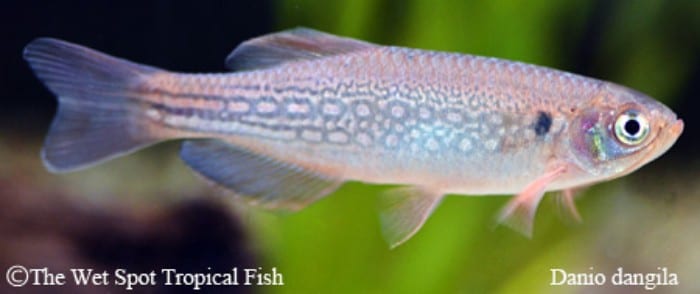Go with the Flow
Go with the Flow
Like fish, there are all kinds of freshwater aquarists. Some meticulously curate and breed rare species, do frequent water changes and put oodles of elbow grease into keeping their tanks immaculate at all times. Others prefer to set up tanks that mostly care for themselves. For those who identify as the latter type, it certainly helps to populate tanks with low maintenance, hardy, and peaceful fish, that are more likely to go with the “flow”. A few examples of such specimens include Devario devario, Danio dangila, and Rhadinocentrus ornatus.
Scientific NameDevario devario
Common NameHatchet Body Danio
Temperature / pH59 to 79°F / 6.0 to 8.0 pH
Native LocationIndia, Nepal, Bangladesh
Preferred DietSmall invertebrates
Moving quite literally with the flow, D. devario (otherwise known as the “Hatchet Body Danio”) is most commonly found swimming through the fast flowing streams of Ganges and Brahmaputra river systems in northern India, Nepal, and Bangladesh. Along with this fast-paced lifestyle comes a multitude of low-maintenance life-history strategies. These Danios are generalist, opportunistic foragers that have the ability to munch any aquatic or terrestrial invertebrate they can get their mouths on, along with filamentous algae, diatoms, nematodes, detritus, and a plethora of other items including fish scales! Thus, these swimmers are unfussy in captivity and will gladly consume offerings like high quality dried product supplemented with occasional live or frozen fare. While constantly on the move, the logical breeding strategy is to scatter eggs with no parental care. In captivity, they will spawn readily in mature, planted tanks. Hatched Body Danios are quite boisterous and a joy to observe. They do require a decent swimming space, and though incredibly peaceful, may upset slow moving tank mates. A schooling species, these Danios should be kept in groups of 8 to 10 individuals. Waters should be maintained with temperatures between 59 and 79°F, pH of 6.0 to 8.0, and hardness of 2 to 15 dH.
Scientific NameDanio dangila
Common NameMustache Danio
Temperature / pH60 to 75°F / 6.5 to 7.5 pH
Native LocationSoutheast Asia
Preferred DietSmall invertebrates
Another Danio, primarily inhabiting fast flowing streams, is D. dangila. Fondly known as the “Mustache Danio”, these fish are incredibly hardy, and though they prefer a fast current, are found and do quite well in sluggish and swampy areas with dense marginal vegetation. These Danios are so adaptable, they colonize new habitats readily, and are found widely throughout Southeast Asia and Oceania. Not only are Mustache Danios resilient, but like their name implies, they are sophisticated handlebar mustached specimens with beautiful shimmering and marbled scale patterns. Like our previous Danio friends, they require a lot of swimming space, and should be kept in conspecific groups of 8-20 species. Due to their high energy level, tank mates should be limited to similarly-sized and robust species. Favoring the consumption of insect larvae in the wild, these fish are unfussy feeders that happily eat offerings offerings of dried product. Best blue-green coloration is accentuated when fed frequent meals of live and frozen fare. Mustache Danios require waters with temperatures between 60 and 75°F, pH of 6.5 to 7.5, and hardness of 2 to 12 dH.
Scientific NameRhadinocentrus ornatus
Common NameOrnate Rainbowfish
Temperature / pH68 to 86°F / 6.0 to 6.5 pH
Native LocationAustralia
Preferred DietOmnivorous
No one goes with the flow more than Australians, and that goes for their native fish as well. R. ornatus, more commonly referred to as “Ornate Rainbowfish”, is a prime example. Most commonly found in the “wallum” coastal habitats of eastern Australia, these fish are tolerant of a wide range of habitat conditions. Though their habitat origin in coastal regions is constantly becoming further degraded by encroaching urban development, these rainbowfish are not considered threatened due to their ability to colonize creeks, swamps, and other slow-moving tannin-stained waters throughout Queensland and New South Wales. This makes them quite easy to manage in captive tanks. Like other rainbowfish, this species exhibits beautiful and reflective red and blue coloration with striking black-edged scales. This coloration is best developed in a species specific tank with dense vegetation. Tank water conditions should be maintained with temperatures of 68 to 86°F, pH between 6.0 and 6.5, and hardness of 4 to 8 dH. It is in these setups that incredible personalities and intricate social systems are observed. As a schooling fish, Ornate Rainbowfish should be kept in groups of 10 to 20 individuals, where males will develop a bit of a pecking order. In the wild, these fish consume a variety of invertebrate snacks in addition to detritus, algae, and other readily available swamp-foods. Leaf-litter provides a great base-diet, and in captivity they can be fed regular meals of high quality dried flake and pellets in addition to live and frozen fare.
Sometimes, we all need to take a load off. This necessity extends to our hobbies, and while keeping immaculate and high-maintenance tanks can be one of the most rewarding experiences for freshwater aquarists, it’s alright to enjoy keeping fish without working so hard. For fish lovers short on time, let the Wet Spot help you put together a low-fuss tank!


